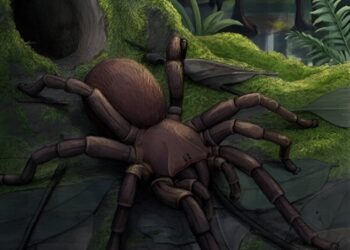Most spiders weave sticky, wet webs to trap their prey, but the feather-legged lace weaver spider, Uloborus plumipes, employs a totally “high-tech” strategy. It spins an extremely thin nano-sized web, which becomes charge with electrostatic energy. Just like dust latches on to your sweater, insects are attracted and stuck to the the web. Biologists believe they’ve figured out how the spider does all of this in a newly reported paper which might help the industry design and develop ultra-strong nano filaments in the future.
An electrostatic web

The UK researchers collected adult female lace weavers from garden centers in the UK and carefully recorded them spin their web using high resolution cameras. In addition, various microscopy technique were used to study the spiders’ internal weaving organs. The cribellum, particularly stood out. This ancient spinning organ is not found in many spiders. It consiss of one or two plates densely covered in tiny silk outlet nozzles, and standing at 60 micrometers it is among the smallest silk glands ever observed
First, the silk emerges as a gooey liquid from the cribellum gland, unlike other spiders which eject their silk intact. As the spider pulls on the silk, it sets into a solid thread, but the kicker is that thousands of tiny fillaments are actively combed out by the spider using hairs on its hind legs. Just like plastic comb charges hair, so do the legs charge the web. The electrostatic fibers are thought to attract prey to the web in the same way a towel pulled from the dryer is able to attract stray socks.
“Studying this spider is giving us valuable insights into how it creates nano-scale filaments,” said Fritz Vollrath, co-author of the new study. “If we could reproduce its neat trick of electro-spinning nano-fibers we could pave the wave for a highly versatile and efficient new kind of polymer processing technology.”
The findings appeared in the journal Biology Letters.






